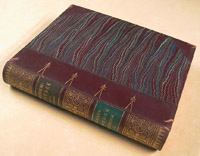The Photochrom Process |
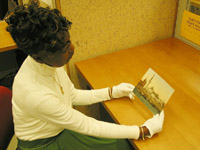 Staff member examining a photochrom print. |
Photochrom prints, also called Aäc, are ink-based images produced though "the direct photographic transfer of an original negative onto litho and chromographic printing plates." Hans Jakob Schmid (1856-1924), who worked for the Swiss firm Orell Füssli, invented the technique in the 1880s. Füssli published the prints through a company with the imprint Photochrom Zürich, later Photoglob Zürich. Other companies that licensed the process starting in the mid 1890s included the Detroit Photographic Company (later Detroit Publishing Company) in the United States and the Photochrom Company in London, England. This photochrom process is not the same as the French color process called "photochrome."1
A characteristic of the photochrom print is a gold-lettered caption along one edge and an inventory number. The initials "P.Z." indicate prints produced at the Photochrom and Photoglob Zürich as shown in this detail from Mythen & Brunnen, Lake Lucerne, Switzerland:
 Detail from http://hdl.loc.gov/loc.pnp/ppmsc.07293 |
The prints look deceptively like color photographs. But when viewed with a magnifying glass the small dots that comprise the ink-based photomechanical image are visible. The photomechanical process permitted mass production of the vivid color prints. Each color in the final print required a separate asphalt-coated lithographic stone, usually a minimum of six stones and often more than ten stones. Monochromatic prints were also issued, including a view of Pike's Peak in Colorado.
To illustrate the relationship between the negatives and the prints, the Library has both the original b&w glass negative in the Detroit Publishing Company Collection (left) and a photochrom print showing the landmark Betsy Ross house in color (center). The photochrom is a detail view of a larger scene. The speckled nature of the colors is an indication of the photolithographic process (right).
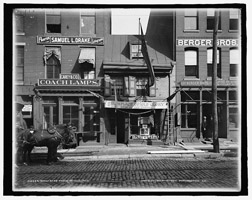 Detroit Publishing Company, Betsy Ross House, Philadelphia. Glass negative, copyrighted 1900. http://hdl.loc.gov/loc.pnp/det.4a08439 |
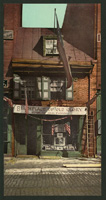 Detroit Photographic Co., Betsy Ross house, Philadelphia. Photochrom print, copyrighted 1900. http://hdl.loc.gov/loc.pnp/ppmsca.17948 |
 Detroit Photographic Co., Betsy Ross house, Philadelphia. Photochrom print (detail from http://hdl.loc.gov/loc.pnp/ppmsca.17948) |
Marketing the Photochrom Prints
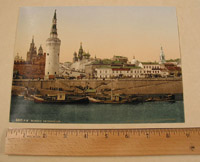 The Kremlin towards the Place rouge, Moscow, Russia, between ca. 1890 and ca. 1900. http://hdl.loc.gov/loc.pnp/ppmsc.03843  The Kremlin towards the Place rouge, Moscow, Russia, between ca. 1890 and ca. 1900. (Back of print) |
Photochrom prints were sold at tourist sites and through mail order catalogs to globe trotters, armchair travelers, educators, and others to preserve in albums or put on display. Boxes that resemble a decorative bound book were also available to store large sets of images.
Printed on thin paper with blank backs, photochrom sizes ranged widely. Most prints are 6.5 x 9 inches, although the United States views in the Library's Photochrom Collection tend to be smaller at 3.75 x 7 inches. Large mammoth plate photochroms [view samples] and panoramic photochroms [view samples] were also produced.
At a time when color photography was still rare, demand for these color images was high. The Detroit Photographic Company reportedly produced seven million photochrom prints in some years. As many as ten to thirty thousand different views were offered. [View a page from a Detroit Photographic Company catalogue]
The Detroit Photographic Company catalog of photochrom prints for 1901 describes the Aäc process of color printing as “the only successful means yet known of producing directly without the aid of hand color work a photograph in the colors of nature. The results combine the truthfulness of a photograph with the color and richness of an oil painting or the delicate tinting of the most exquisite water color. The colors are absolutely permanent and attain the virility and strength of nature so often lacking in hand colored work. The prices are no more than those of ordinary photographs. The inventors have spent thousands of dollars and years of study before reaching their present success.”
The Photographers
The names of individual photographers are rarely identified on the photochrom prints. Initials on the original negatives and entries in the Detroit Publishing Company ledgers at the Colorado Historical Society sometimes reveal the image creator. This view of a Jewish street haberdasher in New York City was probably taken by the Byron firm about 1900 and copyrighted in 1902 by the Detroit Photographic Company.
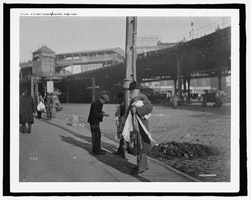 Byron (Firm), A street haberdashery, New York. Glass negative, ca. 1900. http://hdl.loc.gov/loc.pnp/det.4a09004 |
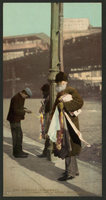 Detroit Photographic Co., A sidewalk haberdashery. Photochrom print, copyrighted 1902. http://hdl.loc.gov/loc.pnp/ppmsca.17955 |
Dating Photochrom Prints
Photochrom prints flourished in the 1890s and early 1900s, and the full span of production years lasted from the late 1880s until well into the 1900s. Clues to when a photochrom was first published can be gained from comparing entries in sales catalogs, such as those issued by the Detroit Photographic Company in 1899, 1901, and 1905. Keep in mind, though, that the original negative or photograph may have been taken many years before the image was printed in color as a photochrom.
1 Steven F. Joseph, "Photoglob Zurich/Orell Füssli & Co." in Encyclopedia of Nineteenth Century Photography (New York: Routledge Press, 2008): 1078-1079. [back to text]
[START OVER] [ NEW SEARCH] [ "ABOUT" MENU] [ HELP]
(December 11, 2008)
